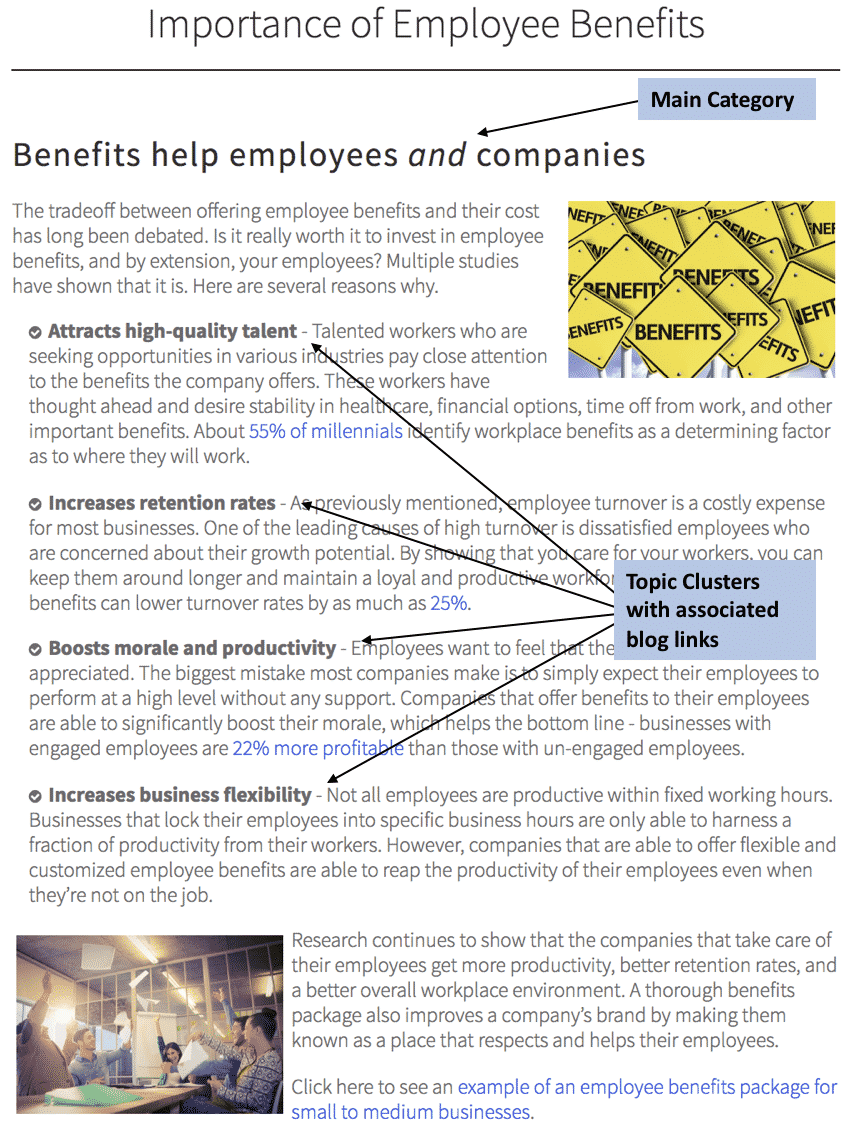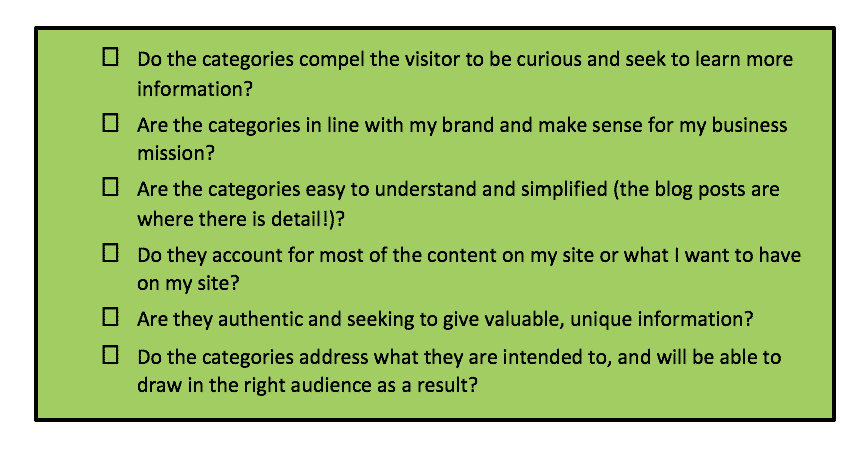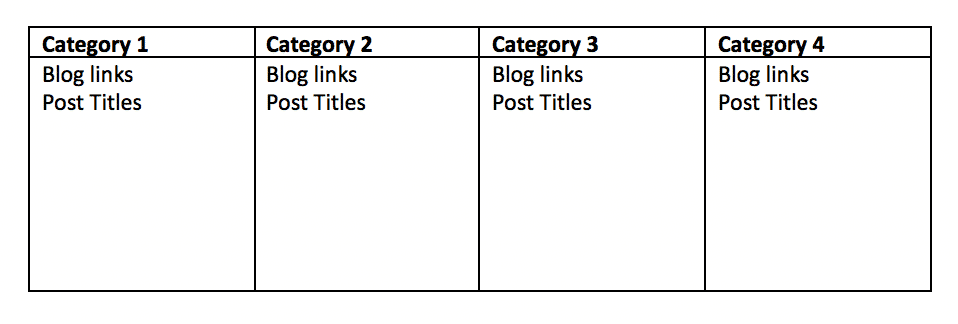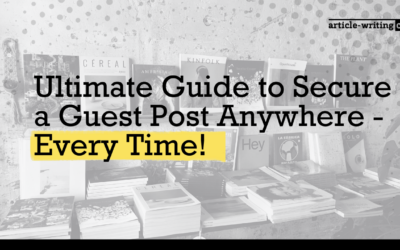What is a Pillar Page?
The latest in SEO and an efficient means of delivering content, pillar pages work on a basic structural and architectural premise: you organize your content into topic clusters, which are broad topics that can encompass a lot of the content from your site under one umbrella. This relatively new and innovative SEO technique comes from the work of Brian Dean, an SEO guru, who as INC says, is “one of the world’s most sought-after SEO experts.” In many ways, he is considered the inventor of the pillar page strategy, and speaks to it heavily in his work to educate individuals on boosting SEO and understanding actionable steps which can garner improved online content, reduced bounce rates, and better lead generation and follow through when it comes to conducting business online. In essence, he is the king as a source of knowledge and information when you find yourself asking, “what is a pillar page?”

Another influential player in the field, HubSpot, also offers key information on pillar pages, seeking to strip the process down to basic actionable steps with an emphasis on driving home its effectiveness and ease of applicability to the everyday business person, blogger or online influencer. In other words, you don’t need to be a Brain Dean to make pillar pages work for you, and they can (and should) be an integral part of your content marketing strategy.
Whether you are going back to basics with Hubspot or understanding the depths and intricacies of pillar pages like Dean, they have a place on your website and it’s just a matter of digging deeper to understand what they are and how you can apply them. Acting as concisely crafted connected information loads, pillar pages allow you to take your content that is separated into individual blog posts and consolidate it into one place. From there, your readers can access a wealth of information and at the same time understand how it is connected, and gain value from a selection of linked data.
Pillar pages are indeed big on offering value. In fact, maximizing value for your readers is arguably one of the main benefits of incorporating pillar pages into your content marketing strategy. As expressed by TABS Analytics vice president of marketing, Robert Baldwin – who recently started working to incorporate pillar pages into his site – “Pillar pages are powerful.” Because when readers and visitors come to your site, and see the homepage, they typically – and quite quickly – do one of two things: either leave immediately or stick around and have a look. The only way they will do the latter is if they can gain value from what they find on your site. And knowing as the website owner, that regardless of the reader’s choice, the time they stay is short, it’s best to offer that value in the fastest and most effective way possible. For this pillar pages are the answer. In fact, as Baldwin describes it, pillar pages are designed such that the formula they use means they offer information in somewhat of an “alluding” way, essentially compelling the reader to want to know more, dig deeper and click through your blog or site to gain more information. The structure of the pillars, with the topic clusters and ease of accessibility of links makes this incredibly easy for them to do, and hence they are far more likely to do it.
More than a framework for your readers to add value and make them stick around however, a pillar page is also important for you, the website creator. It allows you to condense a summary of your online information into one place and provides a platform that you can keep building upon as you generate more content or learn about more content that your readers need. It goes deeper than just consolidating content however. In fact, pillar pages can be a pivotal player in helping you gain new clients, build customer relationships, drive sales and improve your entire business structure.

Why Should I Create a Pillar Page?
While you may think it is enough to simply continue writing blog content as you always have, crafting a post, adding in keywords and pressing publish, this is no longer necessarily the case. The necessities of SEO are changing such that pillar pages are now becoming the “need to have,” in order to stand out and be found online, not simply the “should have.” In other words, answering the question, “what is a pillar page?” is more important than ever.
And it’s to your benefit and the benefit of your business to incorporate them into your content marketing strategy and to strategically craft them with the right words, the right topics and the right message, to leverage them to your advantage. Because really, what you should be focusing on, isn’t why you need to have pillar pages, but what can pillar pages do for you? And the answers are many:
1. Getting Noticed by Google (SEO)
Like anything in the technology, social media and the content world, your ability to garner success comes from staying ahead and staying on top. And arguably, comes from getting noticed by Google. There are millions of searches conducted daily, and research shows that the average click-through-rate for the first position in a search is 19.3%, followed by 10.5% for the second. And then it just decreases down the line. It is safe to say that being at the top is desirable and that means having high search engine optimization for your content.Pillar pages are one of the best ways to increase SEO and get noticed by Google, two critical reasons behind answering why you should create a pillar page. When you craft them right, you not only add the right content as it pertains to your industry and brand, but you also meet Google’s criteria of making sure the content makes sense for what your brand is about, and that what you say you are talking about is what you are actually talking about.
2. Standing out in Your Industry
And when you get found, you get to stand out! Pillar pages are the pillar, if you will, of making you and your brand stand out. As we mentioned above, getting noticed online is huge (and hard), and anything you can do to give yourself an advantage is a welcome solution.Pillar pages allow you to craft a more streamlined, organized and reader friendly space, with less clutter, meeting Google’s preferences for optimal search, and then catering these pages exactly to your niche market and industry, such as tech or health. From there, you can work to become the authority in that industry, with your brand, curating a wealth of information that is easily and accessible to the reader and provides prominent information.
3. Crafting the Customer Journey
Once you are a stand out in your industry, pillar pages have already started to work for you. Standing out and getting noticed means you can start to develop trust with your future clients and are able to build relationships. These are two key aspects of the customer journey, which is critical in boosting business. From there, you can continue to lead your customer on a journey, marked by high value content, that seeks to take them from a lead to a purchasing customer. What you have started them from – simply streamlined, high value content – is now a key player in building loyalty, which makes them keep coming back and ultimately drive sales and boosts business
4. Boosting Improved Website Organization
You can think of pillar pages as a clear and concise way to organize your website, as well as a strategic method of how to go about doing it. If you have been building your website, blog and content for some time, chances are you have a lot built up. And while you may have used categories or tags for each post, simply having a list of posts under a category is not the most user-friendly way for visitors to find content on your site, and it is certainly not easy for google to find it. Not to mention, it doesn’t do you any favours in boosting the degree of professionalism you portray over your site or business.

Really, the list goes on of the plethora of reasons why pillar pages are important and how they can help you, and ultimately, will also offer you as the creator, a more streamline and systematic way to organize your content and know what type of content you need to be writing – and what is unassumingly hurting your brand or what you shouldn’t be writing. Simply from the basics above though, you can see that with the right pillar page development, you will be found more easily online, letting you stand out in your industry, and then be able to craft an ideal customer journey that will bring you more clients and boost business. And isn’t that what you started out to do in the first place?
Before you get started, take a look at this sample pillar page, from Senior Providers Network, talking about employee benefits and note the designation of each component of the page:

Getting Started
Speaking of starting, the only thing left to do now is to tackle how to create a pillar page. And if you are reading all of this thinking that it sounds overwhelming and like a lot of work, you may find yourself inclined to neglect crafting pillar pages and feel that they are not a necessary part of your blog and content strategy. But by now, the value couldn’t be clearer, and in good news for you, we’ve made the how-to steps of how to create your pillar pages equally as easy to understand:
Summary of Steps
- Determine appropriate categories for each pillar page
- Gather corresponding blog posts to use for each page
- Write your pillar pages
- Link pillar pages and blog posts
- Create new blog posts to fill in areas of insufficiency within your pillar pages
Step 1: Determine Appropriate Categories for Each Pillar Page
The first part of creating your pillar pages is to determine what the topic will be for each one and what you want your pillar pages to be able to offer your reader. It is important to craft pillar pages that are going to be of value to your reader, not only so that they can learn something and stick around, as mentioned above, but also so that they are intrigued and want to know more.
We have all found ourselves in that position on a really well-designed website, that is loaded with information, where we are suddenly sucked into the funnel of clicking more and more, and going deeper down the path of what the content is offering. This is what you want with your pillar pages: you want to craft a page that is so categorically comprehensive and navigable that your readers will click on each associated blog link and simply not want to leave. This sequence of behavior illustrates the first stages of building profitable relationships and trust, as mentioned above, and greatly contributes to demarcating the value of your website in the eyes of google due to lower bounce rates and higher retention times.
How do I know what categories to choose?
Herein lies the next question you are probably asking yourself, and it is an imperative one: choosing the categories is indeed one of the most important foundational steps of guaranteeing you are able to produce valuable, scalable pillar pages, and will lay the framework for you to write further pages, further blog posts, and most importantly, to further your business.
The best place to start is to ask yourself the following:

In essence, what is the purpose of your site, the purpose of trying to gain more traffic, of spending your time creating content and of putting any of this out into the world at all?
It sounds deep, or maybe a little over the top, but think of it this way: if you don’t know the answer to that and don’t know the why behind your content and what you are producing, how can you expect your readers to have that, and even more so, how can you expect them to buy from you or support your business?
Part of the reason behind getting really clear on the purpose and why is to make sure that you end up crafting content that is going to reach the right audience. Even if you are creating incredible content, it will not do your business any favors if it is not targeting and drawing in the people who you want to have show up and read it. (Not to mention, Google doesn’t really like that either!)
To help you do this, William Frazier, co-founder of Viabl, and a prolific content creator in his own right, suggests that before you start to create any content, you identify who the right people are by talking to one of them! Find one person who would be your ideal person who you want to reach, or your potential reader, and ask them questions to help find out more about their problem and how you can solve it. This way he says, you’re helping to “solve a real problem, from a real person – not one that you’ve invented.” Furthermore, as he explains, once you talk to one person about their problem, inevitably, there will be others with a similar situation, and your content will start to speak to many people, just as you are hoping.
When you put the time in to speak to people and get real answers, and you have a solution to their problem, you have a big theme or idea. You can then use this to start to craft a framework and foundation to guide the creation your pillar pages.
As you give all of this some thought, and nurture your page construction strategy, use this checklist of things to keep in mind in helping you cultivate the best categories for your content:

Step 2: Gather Corresponding Blog Posts
Once you have decided on your categories, it is now time to assemble the resources you have and determine how to most strategically and valuably share your current content. You have put in a lot of time writing the blog posts on your website and chances are, they are likely not being used to their full potential (or at all) in the way that they are currently accessible to your visitors. Not only do you want to make them more easily accessible, but you want to do this in a way that makes them most likely to be clicked on and read. After all, the posts are only as valuable as the amount they are read and the content they provide.
To get started on organizing your blog posts and blog content, open a document on your computer and make a table. Each column is one of the categories you chose above. From here, go through your website and assess the blog posts you have, copying and pasting the link, with the corresponding title into the appropriate category in the table. Here is a sample of what your table may look like:

- Whether the categories you chose are correct and appropriate, based on the amount of content you have to support them
- Whether you have a lot of superfluous content that doesn’t fit or doesn’t offer value on your site
- Whether there are a lot of areas of missing content which you need to address (we’ll talk about that later!)
After determining the categories and filling in all of the appropriate blog posts on your table, you should start to see the framework of your pillar pages come together. And now that you have the content and can successfully answer, “what is a pillar page,” it’s time to create the pages!
Step 3: Write Your Pillar Pages
Your pillar page is going to be the first thing readers see when they visit each respective category, seeking to figure out that you have chosen, and from there, they will use this to click on links to other areas of your blog. This means, you need to craft pillar pages that are going to make them want to stick around and keep reading, as well as want to click your links to learn more. Furthermore, you want your pillar pages to be easy to navigate and valuable, serving as an efficient means for your readers to get information, and to compartmentalize the facts easily so they are not overwhelmed.
An important contributor to whether or not your pages are read – and whether or not your audience sticks around to keep reading them – is dependent on them getting noticed in the first place, and not simply being lost as another of the millions of generic blog posts available online. Karen Kannegiesser, suggests one of the best ways to craft quality content that stands out and gets noticed is to “know who your ideal client is, and to know what their specific pain points are.” As a staff writer for the International Virtual Assistants Association, Kannegiesser knows a few things about creating good content. She works to create educational material and content that can help current and future VAs optimize the content and services in their own work for clients and high-class companies. She speaks to the need to make sure you are emphasizing the solution to this pain point in your content. This makes the reader feel as if you are caring about them and listening to them. In turn, this emboldens their desire to respond to what you have crafted – by clicking on the blog post links in your pillar page – and you have, in essence, successfully created a page that stands out, gets engagement and has garnered trust, authority and relatability to your reader.
Step 4: Start Linking
This is where you bring everything together. You have now chosen categories that are in line with your brand and business, you have written pillar pages that offer value, succinct information and match this branding. Now it is time to keep adding value by adding links!
But now, you’re thinking to yourself, how should I link to a pillar page? To do this, go back to the table you created above. Here you have the complete list of posts, with their associated links, and everything is already set to go. Because each pillar page is focused around a specific topic and a specific series of blog posts, you can link within the text of each pillar page directly to these posts. Furthermore, you can use some of the links and posts as a call to action at the end of your page to conclude the page and help guide the readers on where to go next. Remember: you are always striving to have your readers stick around, so when you hand to them the next step of the path and make it easy to follow, they are much more likely to do just that.

Step 5: Create New Blog Posts
This is the part where it gets fun. By now you have crafted your pillar pages, taken all of your previously published content and added it into each pillar page where it fits, and should have a much more well-organized blog structure and content matrix supporting your website. In the process of doing this however, you may have noticed some missing information. The beauty of the pillar page strategy is that it is incredibly good at allowing you to see exactly where the insufficiencies are in your content and where you are missing information. In other words, what do you have to offer of value to your readers that isn’t there, or isn’t there in enough quantity or quality?
When you have your content impeccably linked together in topic clusters, the holes become gapingly obvious, and now, not only do you have pillar pages and a beautifully organized website, but you also have a slew of new ideas of what you should write about for your website and to add to your blog! No more struggling to come up with topics or not knowing what your visitors need. Suddenly it all becomes incredibly clear. Now it’s time to start writing!


David is the Founder and Director of article-writing.co, the fastest-growing content creation agency in North America. He has transformed companies by offering high-quality content that has impacted their SEO ranking, revitalized websites with engaging and industry-relevant blogs and website copy, and championed successful email campaign copy.




